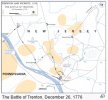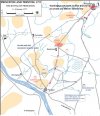Section 7 – Early 1776 - The calm before the British Storm or 13 become 15
December 31 – Arnold departs Fort Cumberland with 600 troops back to Boston. Going back with him is Daniel Morgan and the Virginians.
January 1776 – In response to Dunmore proclamation, Congress votes to allow free Negroes and slaves with permission of owners to the join Continental Army. Washington, Jefferson, and other prominent slave holders who are ardent Patriots free some slaves to join Army. This will be seen as a beginning of softer views on slavery by the Americans.
In February 1776, with much of Nova Scotia outside of Halifax is in Patriot control, Nova Scotia sends three representatives to Philadelphia to participate in the Second Continental Congress.
In February 1776, after the victory in Quebec, Montgomery was able to convene a provincial meeting with the French people of Canada. Christophe Pelissier presided. Other leading Americans, Charles Carroll, John Carol and Benjamin Franklin were present and able to meet with the French Canadians. Many Canadians who were on the fence, who favored the Patriots privately support the American cause.
The Canadians choose three representatives from Quebec, Montreal and Sorel to represent Canada at the Second Continental Congress in Philadelphia. Montgomery worked hard through the winter and spring to develop good, solid relationships between the French habitants and the Americans. Through this, a total of four Canadian regiments were formed to serve in the Continental Army. Many other French Canadians were sympathetic to the Patriot cause. Part of Montgomery’s success was to limit the interaction of the English Americans with the French Canadians. Quebec and Montreal were garrisoned with Canadian volunteer regiments.
(This is in contrast to the relations that David Wooster had with the French Canadians OTL)
Montgomery and Schuyler were content with the capture of Quebec. The main forces that remained with them, wintered in Sorel with garrisons in Montreal and Quebec. During the winter, they prepared the defenses and a plan for the British counter attack that they expected to come in the spring and summer of 1776.
Henry Knox and the Ticonderoga cannon would set out in January from Quebec to trek back to Boston. Aiding him back to Massachusetts are the units whose enlistments have expired. He begins the trek on January 5th from Quebec back to Sorel. He arrives back in Boston mid-April. The Patriots fortify the heights in Charlestown and Dorchester. The British are forced to withdraw from Boston to Halifax in May as the batteries begin to open up on the Royal Navy ships and British positions. The trek of 800 miles from Ticonderoga to Quebec to Boston with the artillery by Henry Knox is one of the overlooked feats of logistics marvel for the revolution. After resting in Boston for a few weeks, Knox personally returns to Canada to rejoin Montgomery.
Washington had plans to land troops without the artillery support in Boston. He was talked out of it for strategic purposes. The Patriots held over a 2:1 advantage in men between the forces displayed around Boston and the British in Boston. But, with the British committed to hold Boston, troops could not be transferred to Nova Scotia or Canada. The thousands of troops outside of Boston did their part in the northern campaigns by keeping the British in Boston preoccupied. Washington did his part as well, a few times he made it appear as though he was preparing an operation to land in Boston.
March 14, 1776 – Arnold and his 600 arrive back in the Boston area. They are greeted with a hero’s welcome. Arnold is especially greeted and promoted in rank by Washington.
December 31 – Arnold departs Fort Cumberland with 600 troops back to Boston. Going back with him is Daniel Morgan and the Virginians.
January 1776 – In response to Dunmore proclamation, Congress votes to allow free Negroes and slaves with permission of owners to the join Continental Army. Washington, Jefferson, and other prominent slave holders who are ardent Patriots free some slaves to join Army. This will be seen as a beginning of softer views on slavery by the Americans.
In February 1776, with much of Nova Scotia outside of Halifax is in Patriot control, Nova Scotia sends three representatives to Philadelphia to participate in the Second Continental Congress.
In February 1776, after the victory in Quebec, Montgomery was able to convene a provincial meeting with the French people of Canada. Christophe Pelissier presided. Other leading Americans, Charles Carroll, John Carol and Benjamin Franklin were present and able to meet with the French Canadians. Many Canadians who were on the fence, who favored the Patriots privately support the American cause.
The Canadians choose three representatives from Quebec, Montreal and Sorel to represent Canada at the Second Continental Congress in Philadelphia. Montgomery worked hard through the winter and spring to develop good, solid relationships between the French habitants and the Americans. Through this, a total of four Canadian regiments were formed to serve in the Continental Army. Many other French Canadians were sympathetic to the Patriot cause. Part of Montgomery’s success was to limit the interaction of the English Americans with the French Canadians. Quebec and Montreal were garrisoned with Canadian volunteer regiments.
(This is in contrast to the relations that David Wooster had with the French Canadians OTL)
Montgomery and Schuyler were content with the capture of Quebec. The main forces that remained with them, wintered in Sorel with garrisons in Montreal and Quebec. During the winter, they prepared the defenses and a plan for the British counter attack that they expected to come in the spring and summer of 1776.
Henry Knox and the Ticonderoga cannon would set out in January from Quebec to trek back to Boston. Aiding him back to Massachusetts are the units whose enlistments have expired. He begins the trek on January 5th from Quebec back to Sorel. He arrives back in Boston mid-April. The Patriots fortify the heights in Charlestown and Dorchester. The British are forced to withdraw from Boston to Halifax in May as the batteries begin to open up on the Royal Navy ships and British positions. The trek of 800 miles from Ticonderoga to Quebec to Boston with the artillery by Henry Knox is one of the overlooked feats of logistics marvel for the revolution. After resting in Boston for a few weeks, Knox personally returns to Canada to rejoin Montgomery.
Washington had plans to land troops without the artillery support in Boston. He was talked out of it for strategic purposes. The Patriots held over a 2:1 advantage in men between the forces displayed around Boston and the British in Boston. But, with the British committed to hold Boston, troops could not be transferred to Nova Scotia or Canada. The thousands of troops outside of Boston did their part in the northern campaigns by keeping the British in Boston preoccupied. Washington did his part as well, a few times he made it appear as though he was preparing an operation to land in Boston.
March 14, 1776 – Arnold and his 600 arrive back in the Boston area. They are greeted with a hero’s welcome. Arnold is especially greeted and promoted in rank by Washington.


